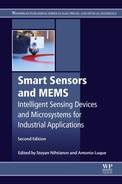Book Description
Smart Sensors and MEMS: Intelligent Devices and Microsystems for Industrial Applications, Second Edition highlights new, important developments in the field, including the latest on magnetic sensors, temperature sensors and microreaction chambers. The book outlines the industrial applications for smart sensors, covering direct interface circuits for sensors, capacitive sensors for displacement measurement in the sub-nanometer range, integrated inductive displacement sensors for harsh industrial environments, advanced silicon radiation detectors in the vacuum ultraviolet (VUV) and extreme ultraviolet (EUV) spectral range, among other topics. New sections include discussions on magnetic and temperature sensors and the industrial applications of smart micro-electro-mechanical systems (MEMS).
The book is an invaluable reference for academics, materials scientists and electrical engineers working in the microelectronics, sensors and micromechanics industry. In addition, engineers looking for industrial sensing, monitoring and automation solutions will find this a comprehensive source of information.
- Contains new chapters that address key applications, such as magnetic sensors, microreaction chambers and temperature sensors
- Provides an in-depth information on a wide array of industrial applications for smart sensors and smart MEMS
- Presents the only book to discuss both smart sensors and MEMS for industrial applications
